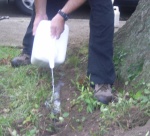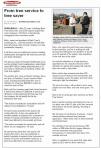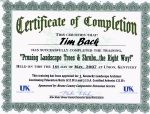As most of you know I am quite passionate about saving ash trees. There have been so many gloom and doom articles about the emerald ash borer in Cincinnati that I decided to write to the Enquirer. And the Cincinnati Enquirer decided to publish it. Here is the article and please read it. Any comments are welcome.
Your ash trees are not doomed to die
June 9, 2010
It is commonly known that the Emerald Ash Borer (EAB) kills ash trees. There is a misconception that there’s no completely effective treatment and eventually the tree must be taken down. This is completely false!
In a recent article, “Emerald Ash Borer Population Growing,” Paul Drury, assistant administrator of Anderson Township, did a great job of describing the problem. However, he concluded his article with a defeatist attitude that revealed a lack of knowledge. Just like Mariemont, and many other municipalities, individuals are not up with current research or are mislead.
Many draw their conclusions from a June 2007 paper, The Potential Economic Impacts of Emerald Ash Borer (Agrilus planipennis) on Ohio, U.S., Communities by Sydnor, Bumgardner and Todd, that was constructed improperly focusing only on removing ash trees. In this paper, the word “save” does not appear one time. The focus is on rip and replace and not saving valuable trees. Today, the authors are rewriting the paper.
In 2009, after another two-year study, the solution to the EAB was revealed and published in Options for Protecting Ash Trees from Emerald Ash Borer. In that report scientists from these universities, Ohio State, Purdue, Michigan State, Wisconsin and Illinois, identified the most effective treatment.
“A new product that is effective for two years or even longer (emamectin benzoate) has altered the economics of treating ash trees… emamectin benzoate is the only product tested to date that controls EAB for more than one year with a single application.”
In a study since 2006, Daniel Herms, PhD, Department of Entomology, the Ohio State University, stated “A single trunk injection of emamectin benzoate (TREE-äge) provided up to three years control,” Multiyear Evaluations of Systemic Insecticides for Control of Emerald Ash Borer. In another paper Herms stated, “The emamectin benzoate trees had less than one larva per square meter or greater than 99 percent control.”
Some argue that removal and replacement is more cost effective than treatment. However, this too is a misconception based on old data. Removing a 12.4-inch tree will lose a landscape value of $2,240, cost an additional $675 for tree and stump removal, and $290 for a replacement 2.4-inch tree.
In contrast, that same 12.4-inch tree could be treated with TREE-äge for only $149, a three-year protection, and less than half that price for municipal parks and streets.
So there you have it. Your trees can be saved by this treatment, proven effective by multiple university studies. I’ve personally saved more than 3,000 trees, and it should be 30,000. The treatment is there, decision makers just need to wake up and use it.
I encourage you to go to your park boards and city councils to ask your leaders why – why aren’t you treating the ash trees with this innovative treatment? It’s time to fight to save the beautiful ash trees.
Tim Back, an International Society of Arboriculture certified arborist since 1997 and owner of Back Tree Service, 742-8733, has saved ash trees for years. Visit his blog on saving ash trees in Cincinnati, www.emeraldashborer.wordpress.com.














